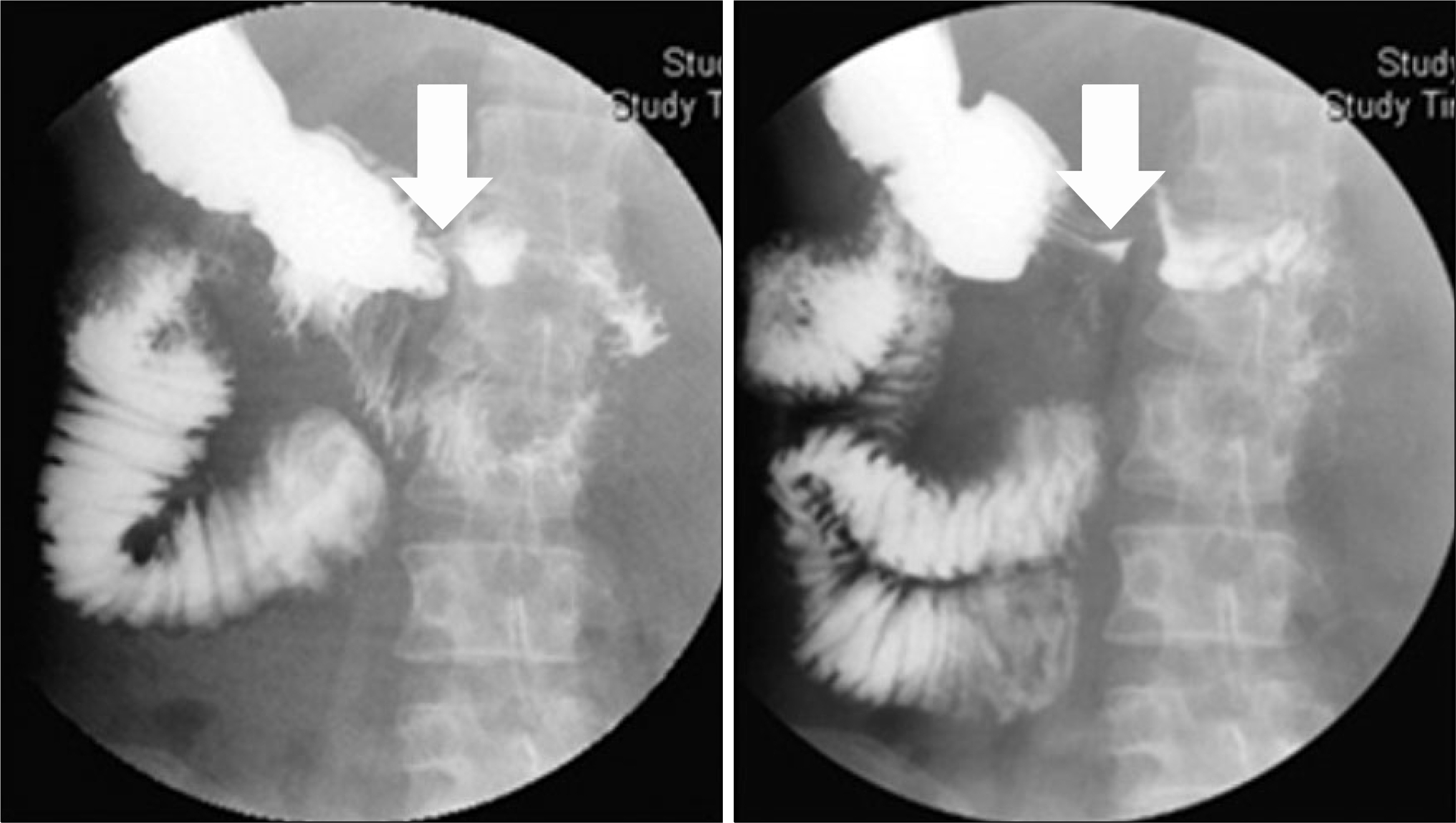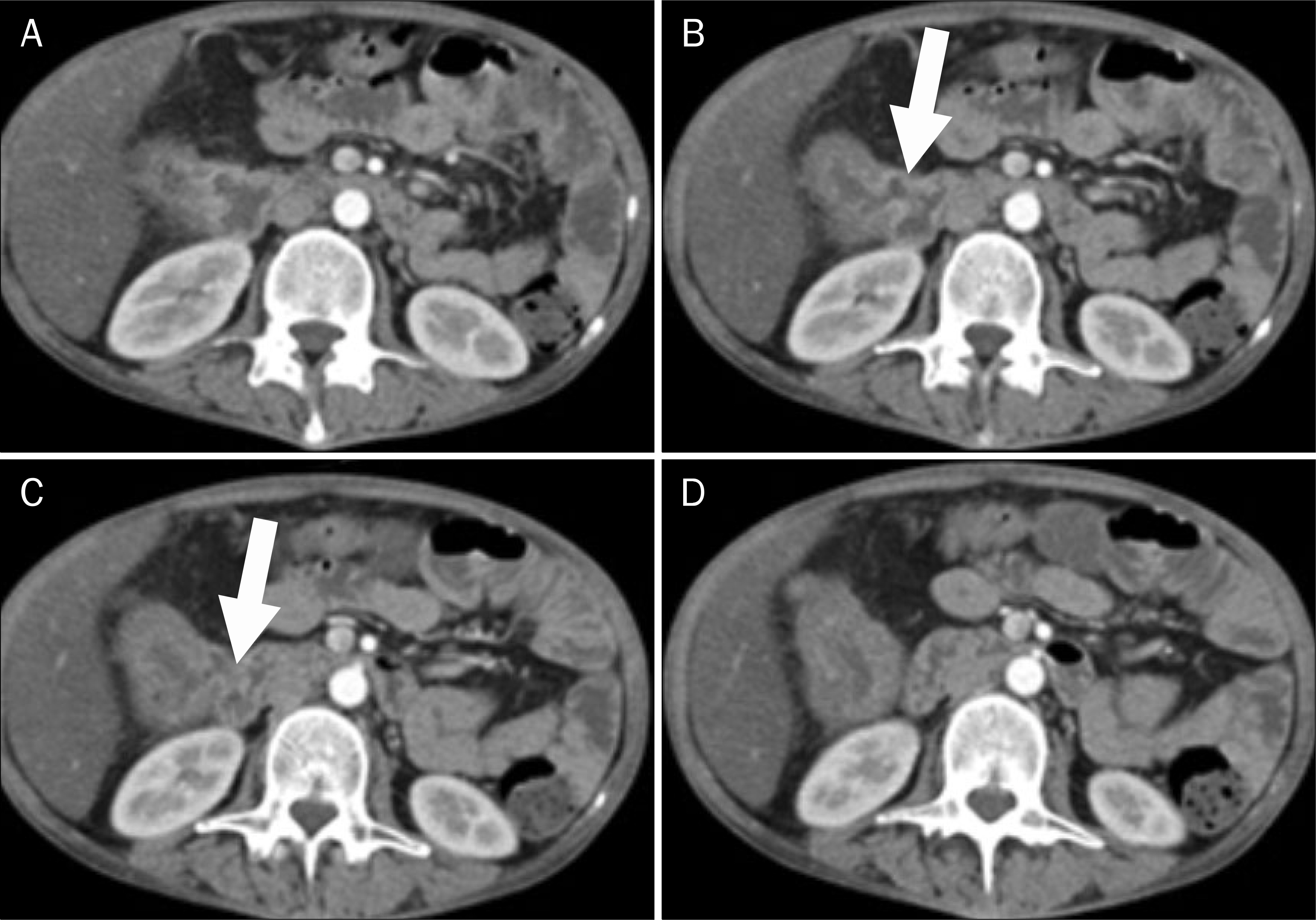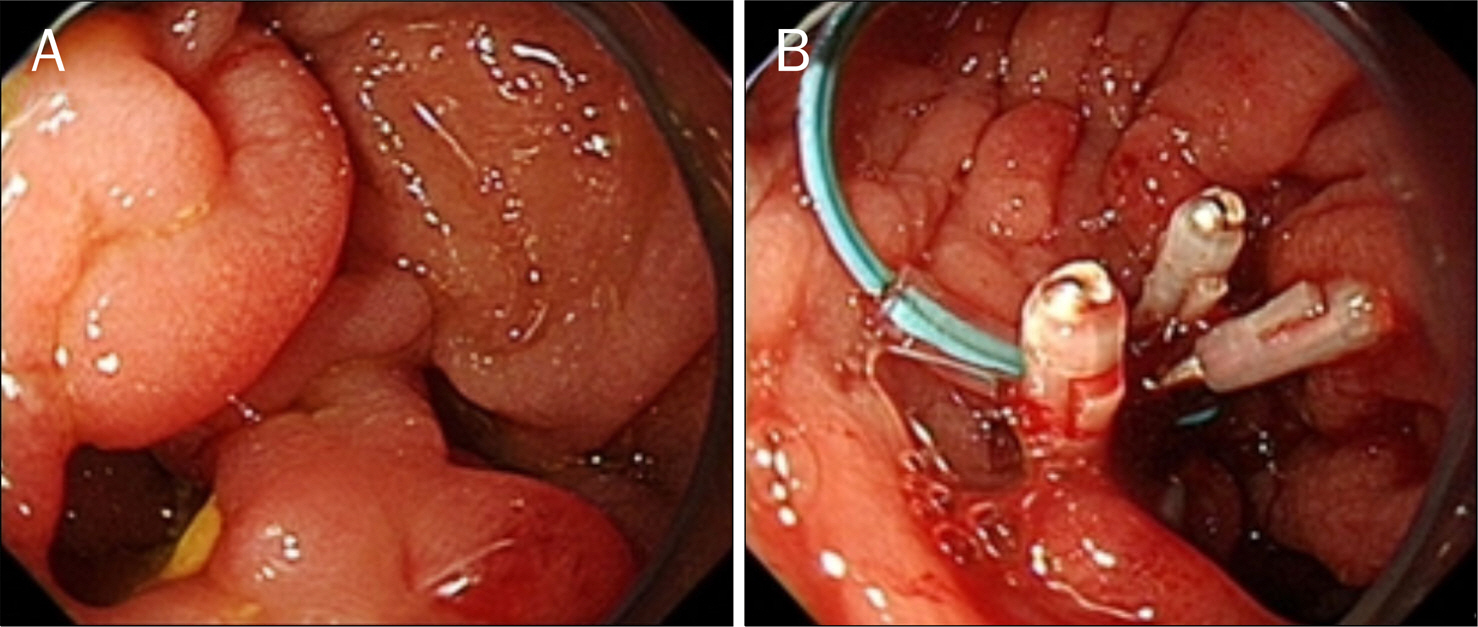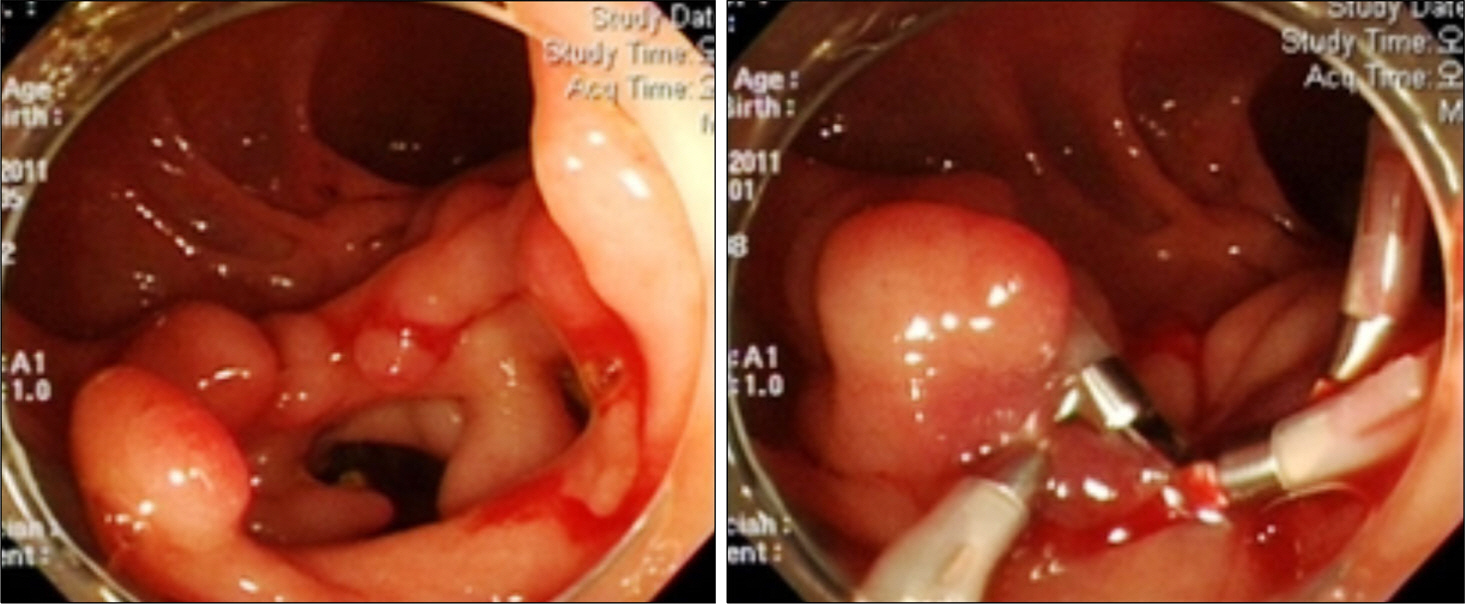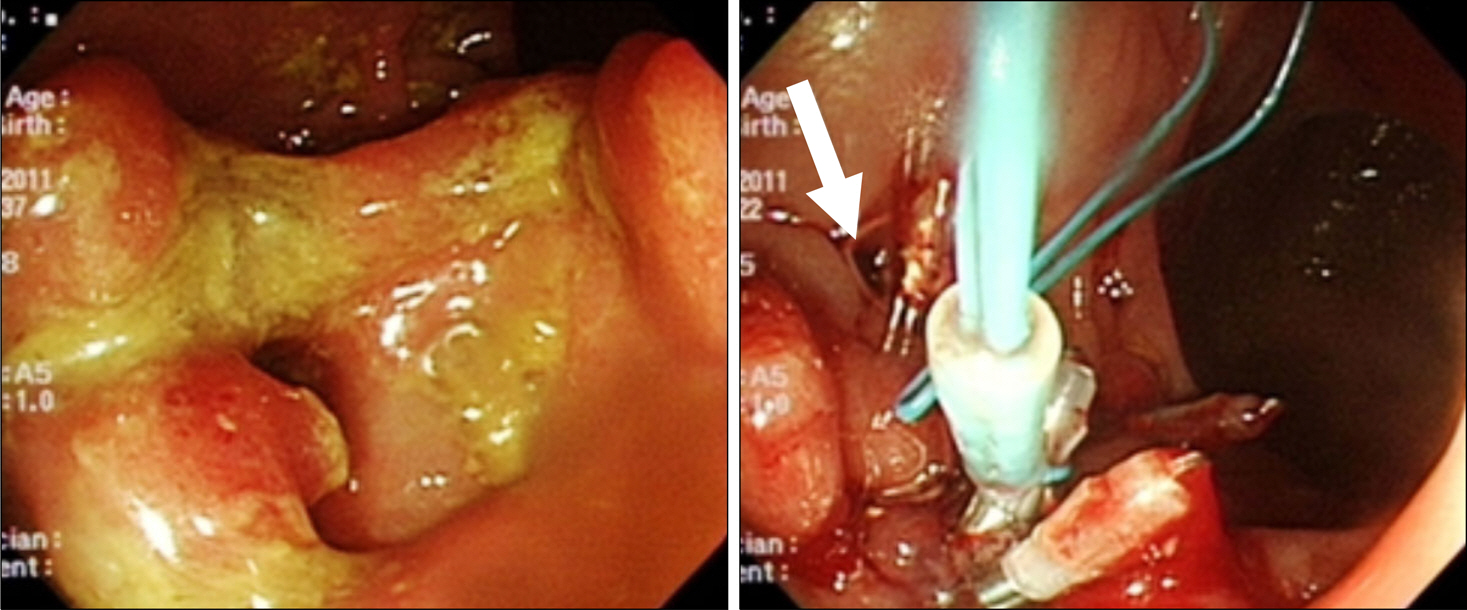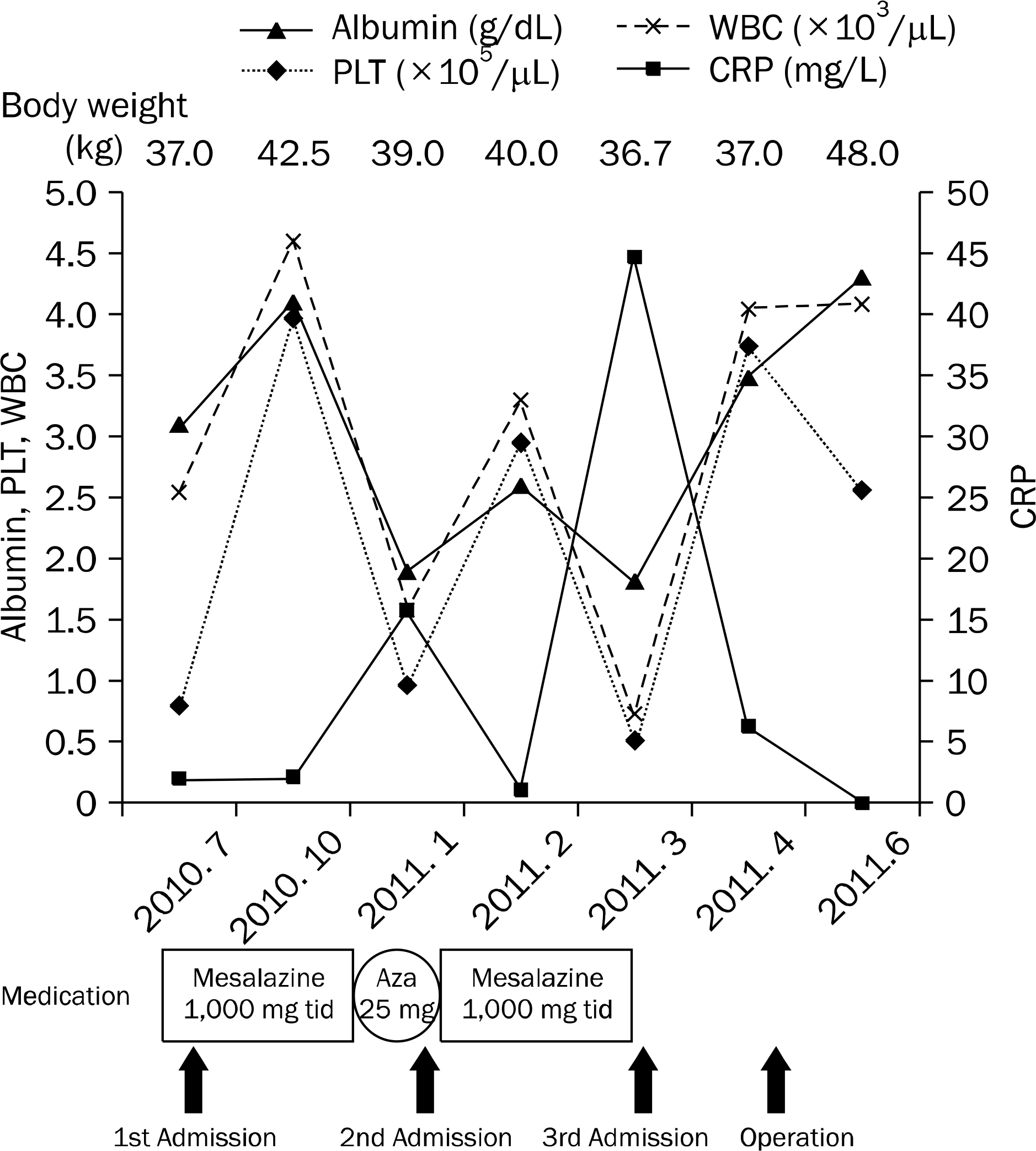Korean J Gastroenterol.
2013 Feb;61(2):97-102. 10.4166/kjg.2013.61.2.97.
Crohn's Duodeno-colonic Fistula Preoperatively Closed Using a Detachable Endoloop and Hemoclips: A Case Report
- Affiliations
-
- 1Department of Internal Medicine, Yonsei University College of Medicine, Seoul, Korea. geniushee@yuhs.ac
- 2Institute of Gastroenterology, Yonsei University College of Medicine, Seoul, Korea.
- KMID: 1775774
- DOI: http://doi.org/10.4166/kjg.2013.61.2.97
Abstract
- Duodeno-colonic fistula is an enterocolonic fistula that occurs as a complication of Crohn's disease. Symptoms of duodeno-colonic fistula are similar to those of Crohn's disease, such as weight loss and diarrhea. The treatment of choice is surgery, although medical treatment may also be considered. However, surgery is recommended when all available medical therapies have been ineffective. In this case, we report a secondary duodeno-colonic fistula due to Crohn's disease that was temporarily managed by an endoscopic procedure with a detached endoloop and hemoclips as a bridging therapy to final surgical repair.
Keyword
MeSH Terms
Figure
Cited by 1 articles
-
Blind Spot of Enteral Stenting for Malignant Duodenal Obstruction due to Colon Cancer: A Rare Case of Duodenocolonic Fistula
Takashi Sasaki, Takafumi Mie, Naoki Sasahira
Clin Endosc. 2021;54(3):443-444. doi: 10.5946/ce.2020.140.
Reference
-
References
1. Farmer RG, Hawk WA, Turnbull RB Jr. Clinical patterns in Crohn's disease: a statistical study of 615 cases. Gastroenterology. 1975; 68:627–635.
Article2. Nielsen OH, Rogler G, Hahnloser D, Thomsen OØ. Diagnosis and management of fistulizing Crohn's disease. Nat Clin Pract Gastroenterol Hepatol. 2009; 6:92–106.
Article3. Ye BD, Yang SK, Cho YK, et al. Clinical features and long-term prognosis of Crohn's disease in Korea. Scand J Gastroenterol. 2010; 45:1178–1185.
Article4. American Gastroenterological Association Clinical Practice Committee. American Gastroenterological Association medical position statement: perianal Crohn's disease. Gastroenterology. 2003; 125:1503–1507.5. Judge TA, Lichtenstein GR. Treatment of fistulizing Crohn's disease. Gastroenterol Clin North Am. 2004; 33:421–54. xi-xii.
Article6. ElHajj II, Abdul-Baki H, El-Zahabi LM, Barada KA. Primary colo-duodenal fistula in Crohn's disease. Dig Dis Sci. 2007; 52:59–63.7. Klein S, Greenstein AJ, Sachar DB. Duodenal fistulas in Crohn's disease. J Clin Gastroenterol. 1987; 9:46–49.
Article8. Greenstein AJ, Kark AE, Dreiling DA. Crohn's disease of the colon. I. Fistula in Crohn's disease of the colon, classification presenting features and management in 63 patients. Am J Gastroenterol. 1974; 62:419–429.9. Pichney LS, Fantry GT, Graham SM. Gastrocolic and duodenocolic fistulas in Crohn's disease. J Clin Gastroenterol. 1992; 15:205–211.
Article10. Benn M, Nielsen FT, Antonsen HK. Benign duodenocolic fistula. A case presenting with acidosis. Dig Dis Sci. 1997; 42:345–347.11. Uza N, Nakase H, Ueno S, et al. The effect of medical treatment on patients with fistulizing Crohn's disease: a retrospective study. Intern Med. 2008; 47:193–199.
Article12. Ye BD, Yang SK, Shin SJ, et al. IBD Study Group of the Korean Association for the Study of the Intestinal Diseases. Guidelines for the management of Crohn's disease. Korean J Gastroenterol. 2012; 59:141–179.
Article13. Levy C, Tremaine WJ. Management of internal fistulas in Crohn's disease. Inflamm Bowel Dis. 2002; 8:106–111.
Article14. Parsi MA, Lashner BA, Achkar JP, Connor JT, Brzezinski A. Type of fistula determines response to infliximab in patients with fistulous Crohn's disease. Am J Gastroenterol. 2004; 99:445–449.
Article15. von Renteln D, Denzer UW, Schachschal G, Anders M, Groth S, Rösch T. Endoscopic closure of GI fistulae by using an over-the-scope clip (with videos). Gastrointest Endosc. 2010; 72:1289–1296.
Article16. Caruso A, Manta R, Melotti G, Conigliaro R. Endoscopic treatment of a large postsurgical fistula using combined fibrin glue spray and vicryl mesh. Dig Liver Dis. 2012; 44:85–86.
Article17. Manta R, Manno M, Bertani H, et al. Endoscopic treatment of gastrointestinal fistulas using an over-the-scope clip (OTSC) device: case series from a tertiary referral center. Endoscopy. 2011; 43:545–548.
Article
- Full Text Links
- Actions
-
Cited
- CITED
-
- Close
- Share
- Similar articles
-
- Endoscopic closure of duodenal perforation using an endoloop anchored by hemoclips
- A Case of Choledocho-Duodeno-Colonic Fistula
- Case of Malignant Duodeno-Colic Fistula Showing Typical Endoscopic Findings
- A Case of Successful Endoscopic Management of Afferent Loop Leakages by Using Hemoclips and a Detachable Snare
- Cholecysto - Duodeno - Colic Fistula : Report of One Case

